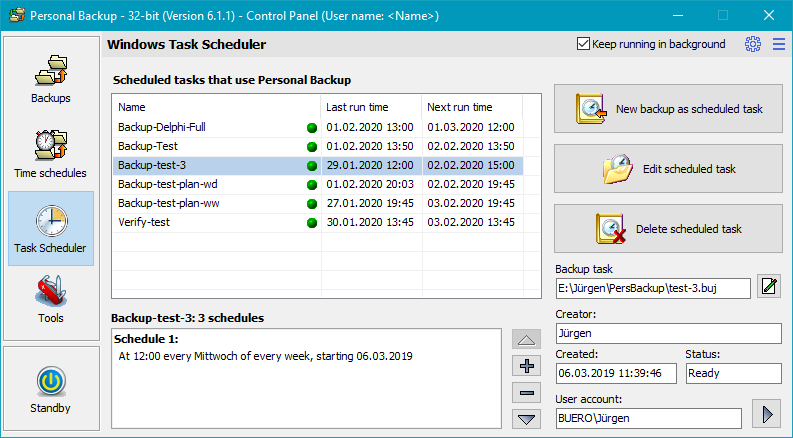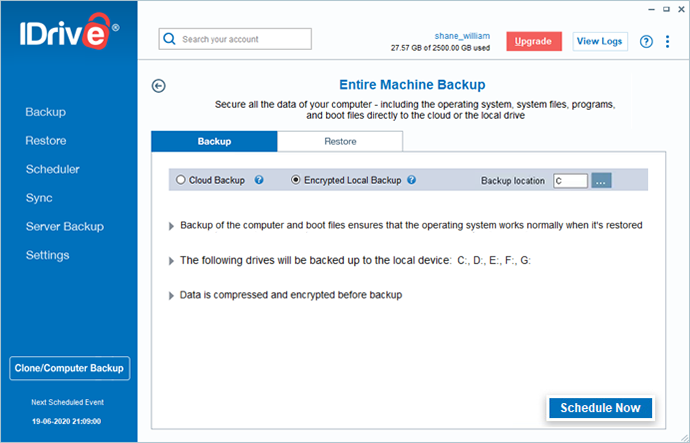

- #Hl backup scheduler how to#
- #Hl backup scheduler full#
- #Hl backup scheduler android#
- #Hl backup scheduler download#
Once Google has finished preparing your download, you will be given the option to download the. You do not need to keep this window open the whole time, as Google will email you with a link to when it is done to download everything. Depending on the size of your photo/drive data, this can take minutes, hours or even days. Once you click Create Export, Google will then prepare your download. Additionally, it will ask you if you want to break the download into smaller blocks (2GB by default) as some file systems have difficulty with larger files (eg FAT32). Once you have selected which data to download (in this case, you photo and/or Drive data), scroll to the bottom and click Next Step.Īfter clicking to proceed, it will then ask you to verify if this is just a 1-off download or if you want to regularly download your google data (with links sent via email).

You can also/alternatively download your Google Drive data here too, just tick the box next to ‘ Drive‘. So, for Google Photos, scroll down and tick the box new to ‘ Google Photos‘:
#Hl backup scheduler full#
This is the full list of applications and services that Google has and you can select them which ones you want to download/migrate. Once you have logged into your Google Account, you will be presented with this screen: Let start!įirst thing to do, is to head over to Google Takeout. Below is how you would use Google Takeout to move your Google Photos and Google Drive data over to a NAS. You just need to head over to Google Takeout and from there you can download your data (from each app, or all) and then you can move that data to your NAS ecosystem as needed.
#Hl backup scheduler how to#
How to Copy Your Google Photos & Drive to QNAP NAS using Google Takeoutįor those that are not aware, all the data that you send to google (via app synchronization, backups, cloud shares, emails, everything!) can actually ALL be downloaded if you want. Let’s talk about the two most popular and straight forward ways to transfer your Google Photos and Google Drive data over to your NAS. So there you go, the tools you can use on your QNAP NAS to enjoy the images that you migrate from your Google Photos into. In the case of NAS drives and photo recognition (such as found here in QuMagie), this is all achieved internally and without external hardware resources sharing your data, as found predominantly in cloud drives. Photo recognition in this manner is not new and something that has already pioneered with Google photos previously, however, Google Photos does this with internet external support. The same can be applied to food and drink, with the QuMagie AI core recognising numerous different cuisine variations. The sub-classifications of photo recognition are hugely impressive too, such as when the QNAP QuMagie application manages to identify different plant and tree varieties (so, not just ‘tree’). The QNAP QuMagie application, originally released almost 2 years ago is their powerful AI-supported photo recognition application that not only supports the majority of the settings of Photo Station but also has a huge degree of categorisation/search options integrated that allow facial recognition, subject/thing automated recognition and still supporting general file, folder and album browsing. In recent years it has been overshadowed a little by their QuMagie application that I will talk about in a moment, but never the less it is still a sound photo tool and massively useful for those long-term backups when moving away from Google Photos and Google drive towards something a little more ‘in-house’.
#Hl backup scheduler android#
Additionally, there are numerous share and privacy options on this photo application that other NAS brands have only just recently implemented, that QNAP has had since the beginning.įinally, there is the integration of Photo Station with the client applications for iOS and Android Photo Backup that allows a lot of the backup of your photos to happen in the background without you knowing. Allowing a larger degree of internal file folder access that is not available from other brands to the same degree, the Photo Station application manages to provide a huge amount of access and fluidity, while still being hugely customizable to boot. The first and original photo management application from QNAP, Photo Station has evolved massively since it was first revealed and is now one of the most adaptable photo programs on any NAS platform. There are TWO main QNAP applications for photography, namely QNAP Photo Station and QNAP QuMagie, however, there is also a wide range of cloud-NAS migration/sync tools too (in the form of HBS 3, HybridMount and more) which I will also touch on later, but for now, we should take a look at the photo apps on offer for photo storage on QNAP NAS when moving away from Google Photos and Google Drive.


 0 kommentar(er)
0 kommentar(er)
